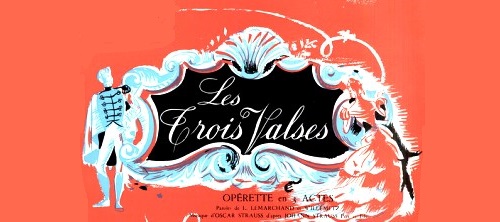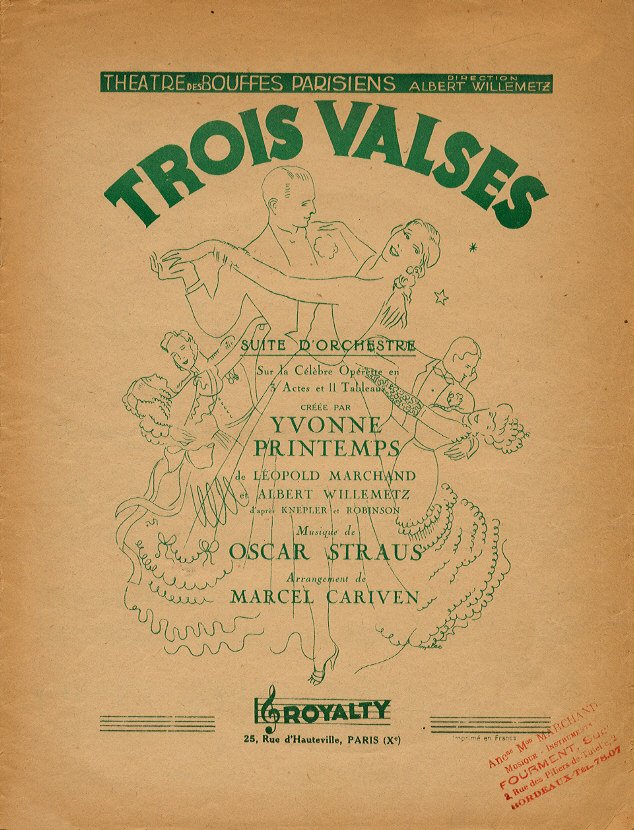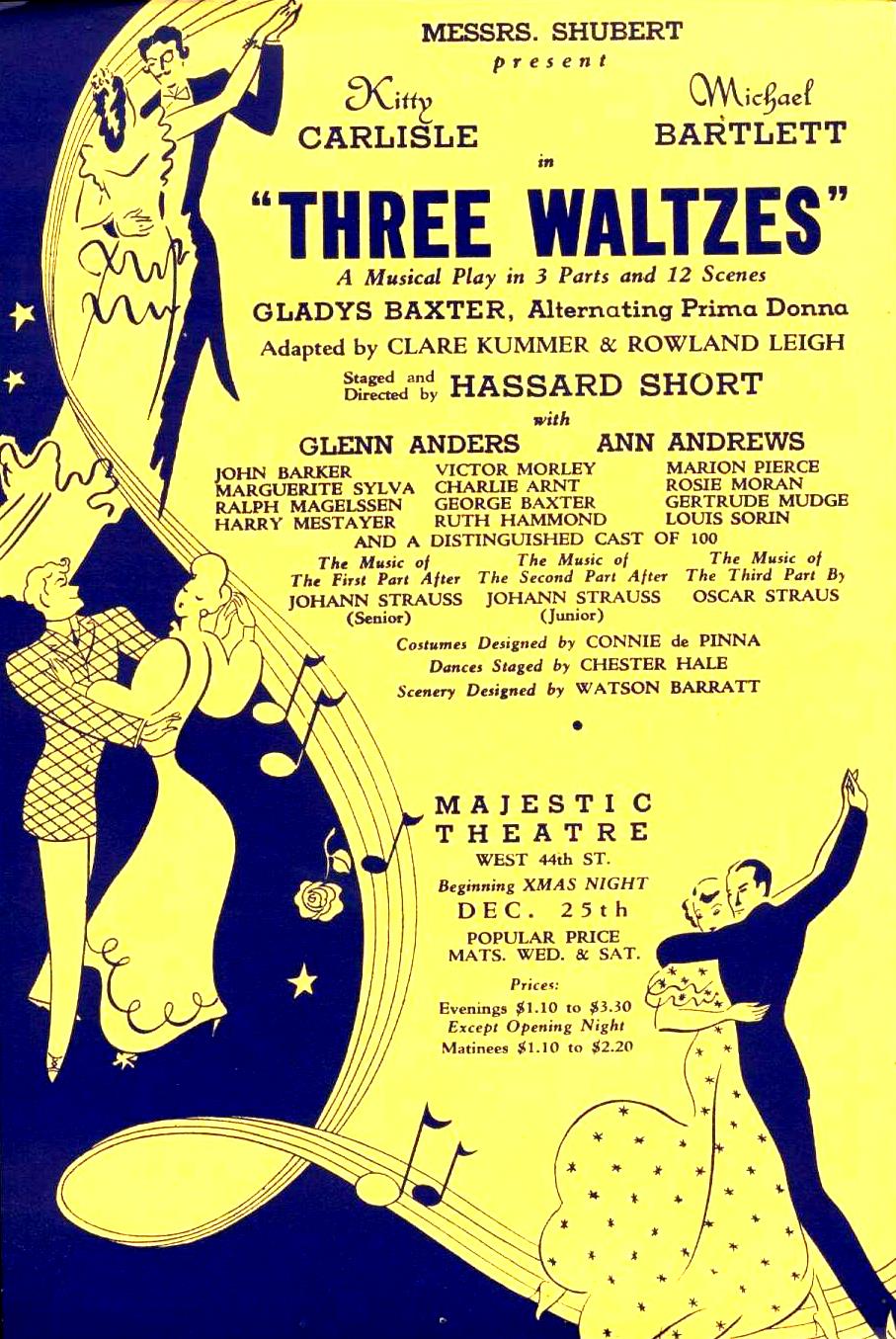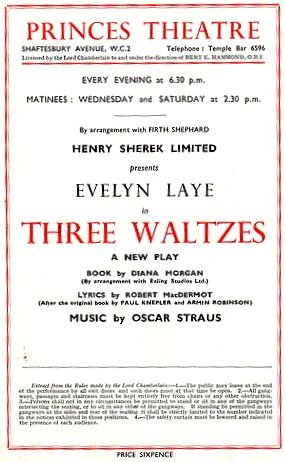Three Waltzes
Musical (1935)

“Drei Wälzer” was first produced in Zurich on October 5th 1935, but it was the Paris Exposition production in 1937 starring Yvonne Printemps and Pierre Fresnay that brought the work great fame. The libretto by Paul Knepler and Armin Robinson set the show in three separate eras, with the music for each of the three acts respectively by Johan Strauss I, Johann Strauss II and Oscar Straus - all adapted by Oscar Straus and with lyrics by Clare Kummer. The New York production opened on Christmas Day 1937 with Kitty Carlisle and Michael Bartlett, but managed just a four month run and 122 performances. The London production had been newly adapted with a new book and new lyrics. Most of the character names had been changed: romantic Viennese Guardsmen and noblemen had become minor English aristocracy, and the “Von Hohenbrunn” dynasty had become the descendants of “Lord Wessex”. Thanks to the drawing power of Evelyn Laye, it did manage a slightly longer run than Broadway. This work is generally regarded as the last worthwhile Viennese operetta to achieve worldwide production. The rest of Oscar Straus’s output was mainly for the cinema, and it was said at the time of his death in 1951 “obituaries for Oscar Straus are also obituaries for the Viennese operetta”.
L’opérette Trois Valses, populaire en France grâce à l’adaptation qui en a été faite pour le couple Yvonne Printemps-Pierre Fresnay n’a pas eu grand succès lors de sa création à Zürich (1935) puis à Vienne quelques mois plus tard. À Londres, en tournée avec Pierre Fresnay, Yvonne Printemps rencontre Oscar Straus qui lui suggère d’aller à Bruxelles où l’on donne la version française de l’ouvrage (1936). Pierre Fresnay et Yvonne Printemps suivent son conseil et, accompagnés d’Albert Willemetz et de son épouse, se rendent au théâtre de la Monnaie de Bruxelles écouter l’opérette : " À la sortie du théâtre, les deux couples sont consternés. Cet opéra-comique, plus qu’une opérette, est long, sans grand charme et chanté de bout en bout par un ténor "
Albert Willemetz, malgré tout, pense que le thème général et la musique ne sont pas sans intérêt. " Je reconstruisis entièrement les 3 actes, raconte-t-il, en axant l’action sur le couple d’amoureux et en arrangeant, naturellement, la partition de telle sorte que les airs les plus importants soient confiés à la voix exquise de la merveilleuse et unique Yvonne Printemps ".
Le triple rôle de Chalencey devient entièrement parlé. Les auteurs transportent le cadre de leur ouvrage à Paris. Les dates choisies pour les trois actes correspondent à trois grandes expositions internationales. Le 21 avril 1937, le théâtre des Bouffes-Parisiens présente ainsi une opérette tout à fait originale dans sa conception : trois valses, trois générations, trois époques. Un imprésario passe et sert de lien commun entre les trois actes.
L'opérette et ses créateurs eurent un immense succès. Robert de Beauplan écrivait dans "L'Illustration" : " Sur un thème viennois, MM Albert Willemetz et Léopold Marchand ont écrit un ouvrage qui fait honneur à l'esprit français ".
En province, avant la deuxième guerre mondiale, l'ouvrage fut brillamment repris par Gabrielle Ristori et Robert Vidalin. Qui se souvent aujourd’hui de ces deux artistes ?
Un film fut tiré de l'opérette en 1938. Aux côtés de Pierre Fresnay et Yvonne Printemps, on remarquait Henri Guisol (Brunner fils), Boucot (Brunner père). Ce film, l’un des rares films musicaux de qualité sorti au cours des années trente, contribua sans nul doute à populariser l’ouvrage.
Après la guerre, on notera deux reprises parisiennes à la Gaîté-Lyrique avec Germaine Roger dans le triple rôle de Fanny, Yvette, Irène. Pierre Jourdan était son partenaire en 1952 et Jean Weber en 1959. En province, l’ouvrage se maintint longtemps au répertoire. On fit appel parfois à des comédiens connus comme Michel Le Royer.
Originally produced as Les Trois Valses for the Paris Exposition of 1937, the show consists of three acts which follows the lives and loves of three successive generations, the first two unfortunate and the third happily paying for all past sorrows. The first act is set in the Exposition of 1867 and uses the music of Johann Strauss Snr; the second act at the 1900 fair uses the music of Johann Strauss Jnr. The final act uses original music by Oscar Strauss
Afficher le synopsis détaillé
PART 1: VIENNA, 1865
CHARACTERS
• Fanny Pichler, a dancer at the Kiiratnertor-Theater
•Beltramini, ballet master at the Kiirntnertor-Theater
•Kaliwoda, ballet stage manager at the Karntnertor-Theater
•Josef Brunner, a theatrical agent
• Johann Brunner, his son
• Countess Katharina Anastasia Schwarzenegg
• Count Franz Schwarzenegg, a field marshal
• Count Egon Carl Maria Schwarzenegg, leader of an army division
•Count Felix Schwarzenegg, a colonel
• Count Herbert Schwarzenegg, a major
• Count Leopold Schwarzenegg
• Count Rudolf Schwarzenegg, a lieutenant
• Frau Zomgriiber Difflinger, a painter
A rehearsal pianist, ballerinas, the Schwarzeneggs' servant
SCENE 1
In the rehearsal room of the Karnmertor-Theater in Vienna the ballerinas are being coached by the ballet master Beltramini . Beltramini is most perturbed that his leading dancer, Fanny Pichler, has so far failed to turn up for this important rehearsal. What can one expect, a lesser ballerina suggests timidly, when one has a count as an admirer? The gentleman in question is Count Rudi Schwarzenegg, a lieutenant in the lancers. When Fanny finally arrives, Beltratnini greets her with a touch of sarcasm, but Fanny is far too full of the joys of the Viennese life to care
The theatrical agent Josef Brunner arrives at the theatre with his son Johann. They are making arrangements for the ballet company to visit Paris, but the stage-manager, Kaliwoda, suggests that there is little chance of persuading Fanny Pichler to leave Vienna and her admirer. Brunner junior suggests that he has enough influence with the girl to win her over to the journey, but his father believes that the eighteen-year-old is allowing his eye for a pretty girl to carry him away. The best they can manage is to get her promise that it will be decided one way or the other by the morrow, and the ballet rehearsal continues.
SCENE 2
In a salon of the elegant palace of the Countess Katharina Anastasia Schwarzenegg, the family has been assembled to discuss Rudi's association with his ballerina. Even Uncle Leopold has been summoned from his home in Pottenstein and he is highly irritated at having to forego his hunting for such a foolishness. Rudi is shown in, and his interrogation begins. His field marshal uncle Franz tells him that he must think of the family name but, to the old Countess's secret admiration, Rudi vigorously defends his right to choose his own wife.
SCENE 3
At her lodgings, Fanny is having her portrait painted whilst awaiting her lover. Her landlady, Frau Zorrigruber, expresses her concern over Fanny's predicament and warns her of the dangers of marrying above one's station, but Fanny will not listen to her and when Johann Brunner comes to try to persuade Fanny to sign the contract for Paris, she refuses roundly.
Finally Rudi arrives, fresh from the family council, and Fanny presses him to tell her what happened, but he merely renews his ardent wooing.
Soon after, Fanny receives a less expected guest, Rudi's Aunt Katharina. She reassures the lovers that she has not come to separate them but only to meet the object of Rudi's love and the cause of his family's concern. She tells Rudi that he has her support, and she assures Fanny that she fully approves of her, but she also wants them to be quite clear about the sacrifices that Rudi will have to make if they are married. He will be obliged to give up his commission.
The sound of a band playing the Radetzky March is heard outside. The procession includes Rudi's own regiment of lancers, and Fanny notices how anxious Rudi is that he should not be seen by his commanding officer. When the soldiers have passed, Rudi prepares to hurry back to the barracks and as Fanny bids him farewell, she hands him the portrait of herself that she has had painted. As she looks after him, she knows that she may never see him again. She has realised she cannot allow him to sacrifice his social position for her, and she has already signed the contract for the appearance in Paris.
PART 2: VIENNA, 1900
CHARACTERS
• Charlotte Pichler, an operetta singer, Fanny's daughter
• Alexander Jensen, an actor
• Steffi Castelli, a soubrette
• Johann Brunner (nom in his fifties), an impresario
• Count Otto Schwarzenegg
• Fritz von Bodenheim, his friend
• Baron Liebinger
• Helene, his wife
• The theatre director, the author, a journalist, theatre personnel, singers, dancers, servants of Baron Liebinger, party guests, head waiter at the. Hotel Sacher
SCENE 4
In the Theater an der Wien, the premiere of the operetta The Marquis of Rivoli is just reaching its conclusion. The curtain falls to loud applause, with the leading performers, Charlotte Pichler and Alexander Jensen, in each other's arms. It is the first big success in Vienna for Charlotte, who is the daughter of the former dancer Fanny Pichler, and the impresario Johann Brunner is on hand to liken the success of her singing to that of her mother's dancing.
Charlotte is elated after her success, but tired by her exertions and by the attentions of the well-wishers and journalists. When Baron Liebinger invites her to a party at his house, she declines graciously but her interest is aroused by the compliments of a young man who introduces himself as Count Otto Schwarzenegg. The young Count tells her that his father always kept her mother's portrait on his desk, and Charlotte recognises him as the son of the Count Rudolf Schwarzenegg of whom her mother had so often spoken. He asks if she will meet him at Baron Liebinger's party, and Charlotte agrees, Brushing aside Brunner's protests that she must be tired, she asks the impresario to see her to the Count's home.
SCENE 5
Over the past four months Otto has been conducting an affair with the Baroness Liebinger. Now it must be ended, for his family are anxious that he should marry. In his time he has had more than his share of flirtatititis (`Lieber Freund, wir mir scheinftNur Liebelei and keine wahre Lieber), but now there will be no more
SCENE 6
At Baron Liebinger's house a large group of guests has assembled for the party and the success of the new operetta and its new star, Charlotte Piechler, is the major topic of conversation. Only Baroness Liebinger seems not to have seen the show, but she is planning to go the following day. Meanwhile, she is trying to speak to Otto, but he avoids her with excuses. The party springs to life with the announcement of Charlotte's arrival. Baron Liebinger welcomes her, and she responds gracefully, but before long she is deep into conversation with Count Otto. 'If the likeness of the portrait in your father's room were not so striking, would you have come on stage to introduce yourself to me?' she asks. He doesn't know, but he has a question in return: 'Would you have changed your mind about coming to Baron Liebinger's this evening if I had not been called Schwarzenegg?' She knows no more than he does.
The operetta's soubrette, Steffi Castelli, is feeling much put out by Charlotte's success. Why can't she achieve the same sort of success? Brunner does his best to help her by allowing her to sing for the guests her comic number from the new operetta.
The relationship between' Charlotte and Otto develops rapidly. Brunner is anxious to see her home safely, but she has already accepted an invitation from the Count to accompany him to Sacher's. Brunner may come and collect her there in an hour or so's time. They depart, leaving Baroness Liebinger, who has still not managed to speak with Otto, to learn secondhand the bitter news that the Count and Charlotte have left together.
SCENE 7
In a private room in the fashionable Hotel Sacher, Otto and Charlotte sit together, talking once again of the feelings that their parents obviously had for each other. Otto by now has his own expressions of love for Charlotte. A knock at the door announces the arrival of Johann Brunner who has come to take Charlotte home, leaving Otto to pour out to the waiter his belief that he has at last found the only woman for him. The head waiter observes stonily that he has heard the Count say that many times before.
SCENE 8
The following day the newspapers are full of the operetta's success. In her dressing room during, the second interval of the operetta's second performance, Charlotte receives a bunch of red roses from Otto, but her co-star, Jensen, and Brunner are worried about the relationship, especially given the unhappy precedent of her mother. Baroness Liebinger comes to the theatre to see Charlotte and after some fulsome praise for the performance she turns to her with some bitter advice about the Count. 'In an article I once read that every Don Juan, every womaniser has his own distinguishing mark,' she says. "With Schwarzenegg it is the phrase about 'the only woman".
Her words strike Charlotte with a cold fear but, as the Baroness leaves, the Count himself appears. He admits that he has made love to lots of women, but he assures her that all that is over since he met Charlotte and that he wishes to marry her. It is now time for Charlotte to take the stage and, when Jensen comes to collect her, she introduces the actor to the Count as her fiancé.
SCENE 9
On stage the chorus are singing prior to Charlotte's entrance. Charlotte comes to her solo, but suddenly she breaks off and collapses into Jensen's arms. The stage manager calls for the curtain to be lowered and apologises to the public for the interruption of the performance due to Fraulein Pichler's indisposition.
PART 3: VIENNA, 1935
CHARACTERS
• Franzi Jensen-Pichler
• Count Ferdinand Schwarzenegg
•Lindtheim, a director for Vienna Film A.G.
• Johann Brunner (now in his eighties)
• Waldner, an actor
• Film technicians of the Vienna Film A.G., actors, an innkeeper, workmen
SCENE 10
In the production room of the Vienna Film Company, a group of dancers are being put through their paces. A film is being made under the title Fanny Pichler's First Love, with Franzi Jensen-Pichler playing the part of her grandmother in the story of Fanny's love for Rudi Schwarzenegg. The book of the film has been written by Johann Brunner, now in his eighties and a man with first-hand knowledge of the real-life romance.
Advance publicity for the film has brought a letter from a present-day Count Schwarzenegg protesting about the subject but the director is little concerned. After all, as he points out, the more the protests the better the publicity! Of more concern is the news that the film's intended leading man, Willy Forster, has had to drop out of the film for contractual reasons. Other names are bandied around, but in vain.
Just then a visitor is announced. It is the same Count Ferdinand Schwarzenegg who has been protesting about the film. The director assures him that they have already made films about Esterhazy, Metternich and Napoleon without any complaints from descendants, but the Count assures them that his concern is purely with historical accuracy and he asks to see the script. The director has been watching his visitor closely and suddenly hi' comes up with the answer to all his concerns: 'Count, you will play the role or Count Rudi Schwarzenegg in our film!' Ferdinand is hesitant but is flattered into acceptance.
The Count is sent off with Franzi and the musical director to practrise their big waltz song, and the two are each astonished to find that the other is also the grandchild of one of the film's leading characters. Seated at the piano, the musical director rehearses them in their big duet.
SCENE 11
In the garden of a suburban hotel, Johann Brunner is enjoying a few glasses of wine to the sound of a Schrammel quartet. He tells the landlord that, though he manages to keep up with all the changes in dance styles, there is nothing to beat a Viennese waltz.
The film director comes to find Brunner with news of the cast change. The old man is horrified to hear the name of Schwarzenegg and, when Franzi appears, he expresses his concern to her. However, when Count Ferdinand follows, Brunner is bowled over by the young man's resemblance to his grandfather and insists that he must indeed play the role. Franzi and Ferdinand sit together and the Count touches lightly on the first words of love, but Franzi, remembering the past relationships between her family and his, shies away.
SCENE 12
Back in the studio, the filming has reached its final day and the farewell scene between Fanny and Rudi into which has been built a grand ballet has been arranged around the Radetzky March. Franzi and Ferdinand play the scene of their grandparents' parting as the band marched past, and they sing their song of farewell. The film is complete.
Brunner worries over all the little departures from reality as he remembers it, and he relives his own recollections of the lovers' farewell. Suddenly, he sees Franzi and Ferdinand locked in each other's arms.
The past and present mix in his mind. This time he will not do anything to part his Fanny and her Rudi.
Seule la musique du 3e acte est originale. La musique des deux premiers actes est adaptée respectivement de Johann STRAUSS père et fils.
ACT 1
1. Opening - Herr Baltramini, Ballet Girls
2.Springtime - Marie Hiller, 8 Men of Manhattan
3.My Heart Controls My Head - Marie Hiller
4. Sextette - Countess von Hohenbrunn, Egon, Herbert, Feliz, Leopold, Count Maximilian
5.Springtime (Is in the Air) - Count Rudolph
6. Finaletto - Countess von Hohenbrunn, Egon, Herbert, Feliz, Leopold, Count Maximilian
7.Vienna Gossip - Ensemble
8.My Heart Controls My Head (reprise) - Marie Hiller
9.Do You Recall (duet) - Marie Hiller, Count Rudolph
10. Finale/Springtime (reprise)- Count Rudolph
ACT II
1. Finale 'Duc de Rivoli' Operetta—"Champagne" - Charlotte Hiller, André Coroit, Ensemble
2.To Live Is To Love - Charlotte Hiller
3.The Only One - Count Otto
4.Paree - Charlotte Hiller, Ensemble, Ballet Girls
5.I'll Can-Can All Day - Steffi Castelli
6. The Can-Can - The Can-Can Girls
7.To Live Is To Love (reprise)(duet) - Charlotte Hiller, Count Otto
8.Scandal - Marquise de Campo, Ralph Magelssen, Author, Ensemble
9. Finale - Duc de Rivoli - Charlotte Hiller, André Coroit, Ensemble
ACT III
1.The History of Three Generations of Chorus Girls - Ladies Ensemble
2. Opening: Ballet Rehearsal - Ballet Girls
3.Radetzky March - Dancing Girls
4.Our Last Waltz Together (duet) - Franzi Coroit Hiller, Count Max
5.The Olden Days - Karl Brenner, 8 Men of Manhattan
6. Finale — The Three Waltzes: The Waltz of Today, the Waltz of 1900, the Waltz of 1865 - Franzi Coroit Hiller, Count Max, Corps de Ballet, Ensemble
Aucun dossier informatif complémentaire concernant Three Waltzes
Aucun dossier informatif complémentaire concernant Three Waltzes

Version 1
Three Waltzes (1937-04-Théâtre des Bouffes Parisiens-Paris)
Type de série: RevivalThéâtre: Théâtre des Bouffes Parisiens (Paris - France) Durée : Nombre : Première Preview : 21 April 1937
Première: 21 April 1937
Dernière: InconnuMise en scène : Chorégraphie : Producteur : Star(s) : Avec: FRESNAY (Pierre) … Octave, Philippe et Gérard de Chalencey / DARY (René) … Brunner fils / JULLIEN (Henry) … Brunner père / FELLS (Georges) … Dulaurier, l'assistant / BLANCHE (Louis) … Beltramini, le Président de Chalencey, le compositeur, le producteur / PRINTEMPS (Yvonne) … Fanny, Yvette et Irène Grandpré / LAMBRAY (Yahne) … La Douairière de Chalencey / PARIS (Regina) … Mlle Castelli, Mlle Raphaelson / MISSIA … Céleste, Mme Jules / ROQUES (Emile) … Le Maréchal de Chalencey, Le Directeur, Un général / NUMES fils (André) … Cyprien de Chalencey, Le Pompier, le Machiniste

Version 2
Three Waltzes (1937-12-Majestic Theatre-Broadway)
Type de série: Original BroadwayThéâtre: Majestic Theatre (Broadway - Etats-Unis) Durée : 3 mois 2 semaines Nombre : 122 représentationsPremière Preview : 25 December 1937
Première: 25 December 1937
Dernière: 09 April 1938Mise en scène : Hassard Short • Chorégraphie : Chester Hale • Producteur : Star(s) :

Version 3
Three Waltzes (1945-03-Princes Theatre-London)
Type de série: Original LondonThéâtre: Shaftesbury Theatre (Londres - Angleterre) Durée : Nombre : 187 représentationsPremière Preview : 01 March 1945
Première: 01 March 1945
Dernière: InconnuMise en scène : Norman Marshall • Chorégraphie : ???? ???? • Producteur : Star(s) : Avec: Evelyn Laye (Katherine/Katie/Kay), Esmond Knight (Richard/Dickie/Dick), Charles Goldner (John Brunner), Bruce Winston (Stanislaus Vayda)
Pas encore de video disponible pour ce spectacle